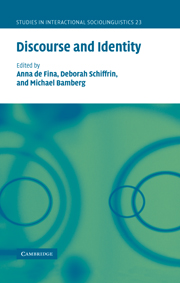Book contents
- Frontmatter
- Contents
- List of contributors
- Introduction
- Part I Overview: theory, method and analysis
- Editors' introduction
- 1 Narrative and identity: the double arrow of time
- 2 Footing, positioning, voice. Are we talking about the same things?
- 3 Small and large identities in narrative (inter)action
- 4 From linguistic reference to social reality
- Part II Private and public identities: constructing who we are
- Part III The gendered self: becoming and being a man
- Part IV The in-between self: negotiating person and place
- References
- index
3 - Small and large identities in narrative (inter)action
Published online by Cambridge University Press: 09 November 2009
- Frontmatter
- Contents
- List of contributors
- Introduction
- Part I Overview: theory, method and analysis
- Editors' introduction
- 1 Narrative and identity: the double arrow of time
- 2 Footing, positioning, voice. Are we talking about the same things?
- 3 Small and large identities in narrative (inter)action
- 4 From linguistic reference to social reality
- Part II Private and public identities: constructing who we are
- Part III The gendered self: becoming and being a man
- Part IV The in-between self: negotiating person and place
- References
- index
Summary
Introduction
Research on identities in narrative increasingly shares with the rest of discourse studies the view that identities are not given entities, static properties, or finished projects. Instead, they are practical accomplishments that are constructed – and even deconstructed – online in the “everyday flow of verbal interaction” (Widdicombe and Wooffitt 1995: 218). Emphasis on the emergence of identities in discourse, particularly in interactional sites, where they can present a multiplicity of meanings, brings together approaches to discourse as diverse as social constructionism and conversation analysis (Widdicombe and Antaki 1998: 201). Nonetheless, there is less convergence on how the discourse constructions of identities relate to factors that are external to a specific interactional situation (sic. exogenous). In studies of identity constructions through narrative, the dominant view seems to be that pre-existent, socioculturally available – capital D – discourses are drawn upon and employed by tellers in the course of narratives in order to construct, justify, and explicate a sense of ‘self’ and, when applicable, ‘other’ (e.g. see Kerby 1991). In this process, narrative is seen as a privileged mode for self-construction and a unique point of entry into trans-situational features of the self and identity as those emerge in a person's (ongoing) life story (for a discussion see Lucius-Hoene and Deppermann 2000: 201). In view of this exigency, the type of narrative that has monopolized identity analysis is that of autobiography. As a rule, (natural) autobiographical narratives or life stories occur in research interviews.
- Type
- Chapter
- Information
- Discourse and Identity , pp. 83 - 102Publisher: Cambridge University PressPrint publication year: 2006
- 29
- Cited by



